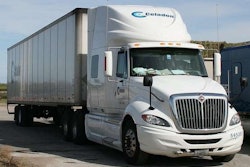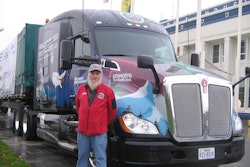 A panel of fleet executives at last month’s McLeod Software user conference in Birmingham, Ala., discussed ways to combat driver turnover.
A panel of fleet executives at last month’s McLeod Software user conference in Birmingham, Ala., discussed ways to combat driver turnover.In October, a panel of fleet executives at last month’s McLeod Software user conference in Birmingham, Ala., agreed that setting the right expectations with drivers is the most effective way to combat turnover. The discussion revolved around the following topics:
1. Setting expectations
The panel agreed that setting expectations with drivers is critical in the recruiting process. All spokespersons said they can better meet expectations by offering a variety of career options that include over-the-road, dedicated and team operations. They also stressed developing personal relationships with drivers and keeping their pay, mileage and home-time commitments.
“It really starts with the fleet manager and driver relationship,” said Paul Simmons, chief operating officer on Interstate Distributor, adding that driver retention is not just a fleet manager’s responsibility. “Every interaction in the office is an opportunity to build trust with drivers,” he said. “How the company sells capacity, how it plans loads and processes payroll and more – it really becomes a one-team event around driver retention.”
2. Streamlining orientation
When drivers are scheduled to attend orientation meetings at Decker, the company’s president makes a personal welcome call. A welcome kit awaits drivers in their hotel room prior to the meetings. Decker brings drivers in by bus, rental car and airplane – all paid for by the company in advance, said Jennifer Brim, director of fleet management.
After orientation, drivers get another welcome kit with a new tractor assignment. Decker has two full-time “driver services” staff members that help resolve any issues that drivers may have during their employment, she said.
Milan has improved its orientation experience by reducing the time spent in meetings that once took 2½ days. “Drivers were relatively bored,” said David Dallas, senior vice president. They now complete training online before they arrive to spend one day at the office for orientation.
“This helps them earn money and get back on the road,” he said. All three panelists said their companies pay drivers about $400 for attending orientation training meetings.
3. Keeping commitments
Every month, Milan executives talk to drivers individually about their performance and ask what they could do better as a company. A recent issue that surfaced was detention at shippers’ docks. Many drivers, especially those new to the industry, expect to be loaded or unloaded within two hours of arrival, Dallas said.
Milan uses McLeod Software’s detention module to notify customers immediately when assets and drivers are delayed. The software enables management to notify drivers within 24 hours of a detention event if they will receive extra compensation for that particular load.
“In the past, it took a week or so before (detention pay) hit their check,” he said. “There was a lot of discontent.”
Another way Milan uses its McLeod LoadMaster system is to track drivers’ mileage every week versus its commitments. Tracking this data is helpful to coach drivers on what they need to do to reach their goals, such as possibly changing their schedules.
“This helps the relationship with drivers not be antagonistic,” Dallas said.
Decker has drivers fill out an expectation sheet during orientation meetings. Before the first dispatch, drivers discuss home time, mileage and other expectations with operations and fleet managers. The company keeps a scorecard on driver managers and drivers for key areas of performance and retention, Brim said.
4. Career path
The panel also discussed career options for drivers to suit their individual needs. Interstate Distributor has a career progression program that includes an opportunity for drivers to earn extra money by recruiting and training drivers themselves, such as a family member or friend, to earn more money as a team operation.
All three panelists said that growing dedicated operations is a focus for their companies to offer better driving jobs. Milan also has been successful this year by using slip-seat operations in its traditional over-the road business to create more consistent routes for drivers, Dallas said.
The panel did not delve into driver pay, though Dallas did mention that Milan drivers and office staff have the same number of paid vacation days, which increase with tenure for both. The company also has removed its cap on drivers’ mileage pay.
“Every year that a driver stays, he can earn more and more money for as long as he wishes to stay with us,” he said.













